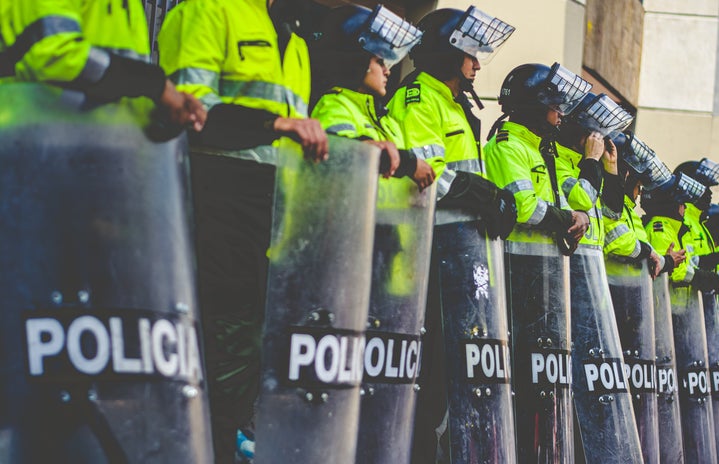On May 4th, 1970, four Kent State University students were murdered by the National Guard during a Vietnam War protest on campus. As a current student of Kent State University, this incident occupies my mind daily, and I cannot help but think about how the incident compares to situations in today’s political climate.
The backstory
On April 30th, 1970, President Nixon permitted the United States military to invade Cambodia, a neutral country bordering Vietnam. North Vietnamese troops were using Cambodia as a hiding place and part of the Ho Chi Minh Trail (a route used for supply transportation).
Nixon’s decision was deemed controversial as he had not discussed the invasion with his Secretaries of State and Defense or Congress. Politicians received the news at the same time as the American public when the president made the announcement on national television days later. Members of Congress accused Nixon of committing an illegal act, as there was no congressional vote. The public felt betrayed as well, which led to much civil unrest. Protests erupted across the nation, especially on college campuses.
The Days Leading up
Protests in Kent actually began on May 1st, three days before the shooting, as rumors of the Cambodian infiltration sparked a lot of anger on campus. Students gathered within the Commons, a large grassy field in the middle of campus. Students spoke out against Nixon as well as the war for the hundreds of people there.
On that same night, students were damaging police cars and downtown businesses, leading Mayor Leroy Satrom to close down the city of Kent early. The unruly crowd grew large and police then used tear gas to disperse them.
The following day, there were various rumors on campus that threats had been made against the city of Kent as well as the school. Mayor Satrom requested the presence of the Ohio National Guard who would arrive later that evening at the campus ROTC building up in flames. Multiple arrests were made against protestors clashing with guardsmen and firefighters. May 3rd was a quiet, sunny day on campus, students were even having friendly interactions with some of the almost 1,000 guardsmen currently at Kent.
May 4th, 1970
On Monday, May 4th, around 3,000 students and protesters once again met at the Commons for a planned protest. The initially peaceful protest was watched by around 100 guardsmen with M-1 military rifles. Though the event was peaceful, the crowd was still ordered to disperse by the national guard.
The protesters refused to disperse and began to shout at the guardsmen. National Guard General Robert Canterbury ordered his men to load their weapons and fire tear gas at the protesters. The guardsmen forced the crowds to the other side of a hill until they reached the fencing of a football practice field. The guard then realized they were enclosed by the mob of protesters, who were shouting and throwing rocks. The men retreated to the top of the hill and 28 of them turned around and fired their guns. Some aimed into the air, and some aimed straight into the group of protesters.
The actual shooting lasted only 13 seconds and roughly 70 shots were fired. Four Kent State students were killed that day—Allison Krause, Jeffery Miller, William Shroeder and Sandra Scheuer. Nine other students were injured. Shroeder died due to a shot in the back, and two others were injured in the same way.
A Country FOrever ALtered
Trials eventually followed after the shooting, many guardsmen claimed they feared for their lives that day, and had no choice but to utilize their weapons. Today, there are still disagreements and conflicting statements from protesters and National Guard members regarding their safety.
As part of the settlement, the National Guard stated “In retrospect, the tragedy… should not have occurred. The students may have believed that they were right in continuing their mass protest in response to the Cambodian invasion, even though this protest followed the posting and reading by the university of an order to ban rallies and an order to disperse… Some of the Guardsmen on Blanket Hill, fearful and anxious from prior events, may have believed in their own minds that their lives were in danger. Hindsight suggests that another method would have resolved the confrontation…”
After the events of May 4th, America reached a turning point in how its people felt about the Vietnam War and all wars in general. Nixon went on to create the President’s Commission on Campus Unrest after a similar incident happened at Jackson State University. The Commission made the following statement regarding the Kent State Shooting: “Even if the guardsmen faced danger, it was not a danger that called for lethal force. The 61 shots by 28 guardsmen certainly cannot be justified. Apparently, no order to fire was given, and there was inadequate fire control discipline on Blanket Hill. The Kent State tragedy must mark the last time that, as a matter of course, loaded rifles are issued to guardsmen confronting student demonstrators.”
The effect that the shooting had on American culture was astounding, but in no way shocking. Neil Young and Crosby, Stills and Nash released a song called “Ohio” about the events that took place on May 4th. The following year the voting age was lowered to 18, a victory for students and young adults alike.
A New Era of Protest
In the fall of 2022, university students in Iran staged sit-down protests at campuses across the nation. The protests came after a young woman was arrested for not wearing her hijab correctly. Hundreds of students have since been arrested for protesting the government, only fueling the already angry citizens to hold more sit-ins.
Universities are not protected from the lethal force in Iran. Union of Islamic Iran People Party leader Azar Mansouri tweeted, “Universities should be protected and be a safe space for students,” regarding the arrests of students. Besides students, more than 14,000 protesters have been arrested by the government since the start of the protests.
The Irani government fails to understand that halting peaceful protests using force and the threat of violence will only inspire more people to speak out, much like the Vietnam War protesters at Kent State in 1970.


